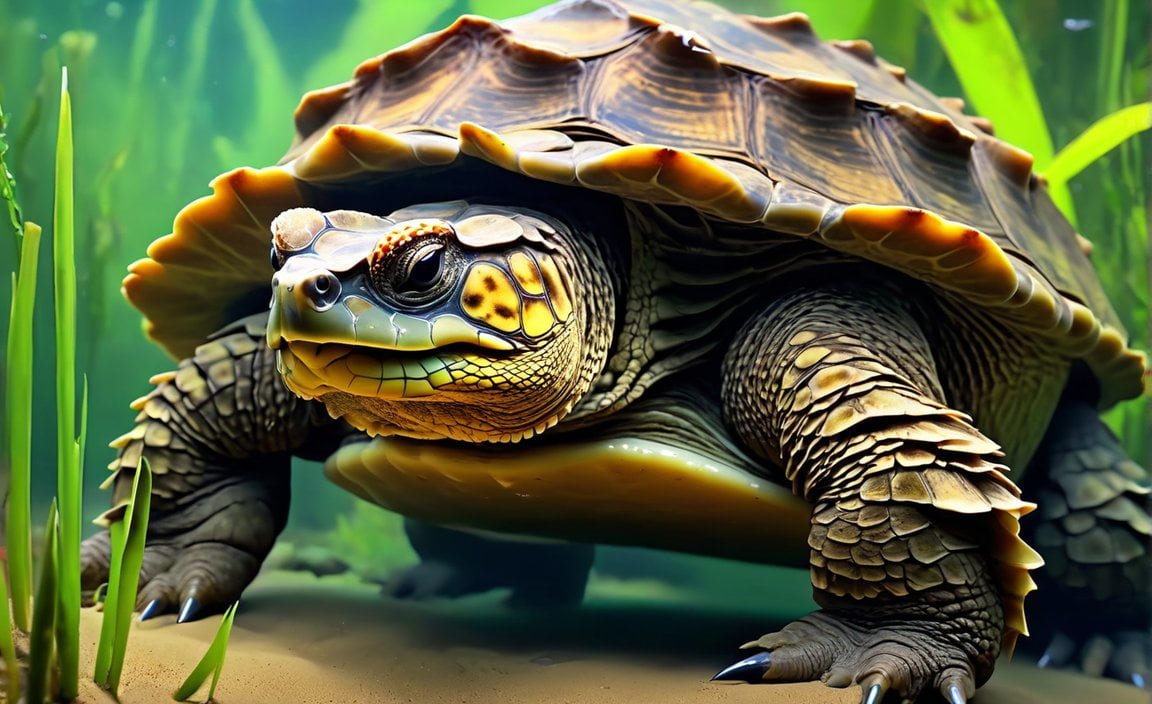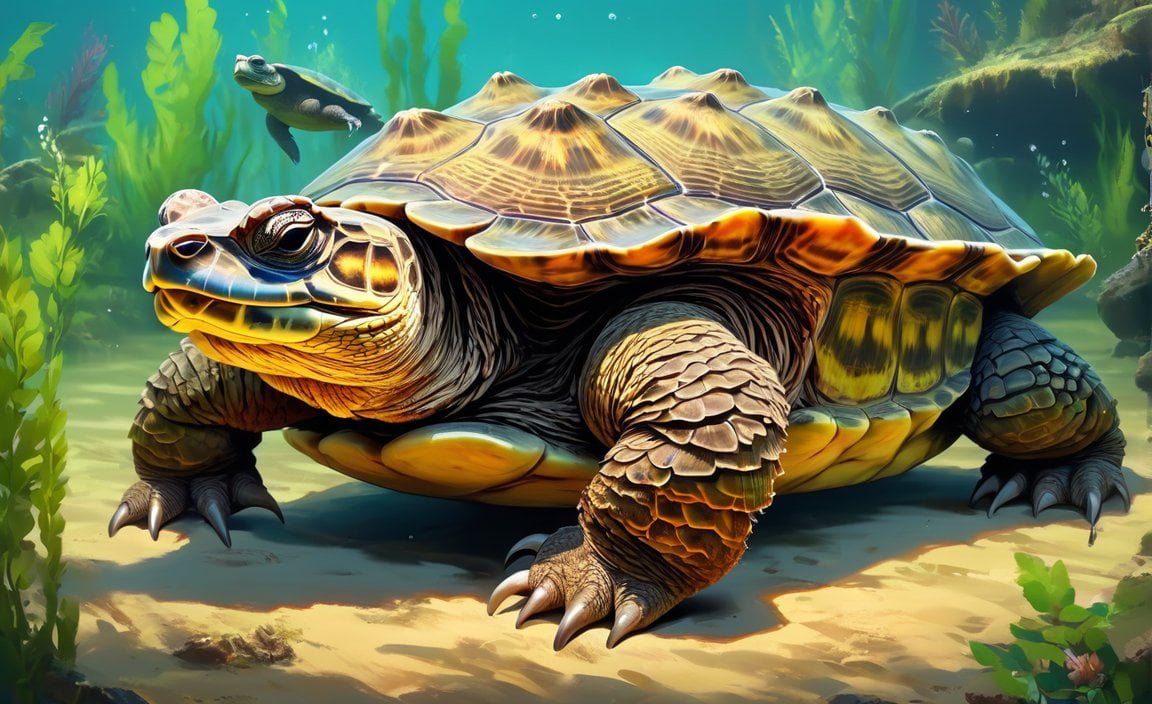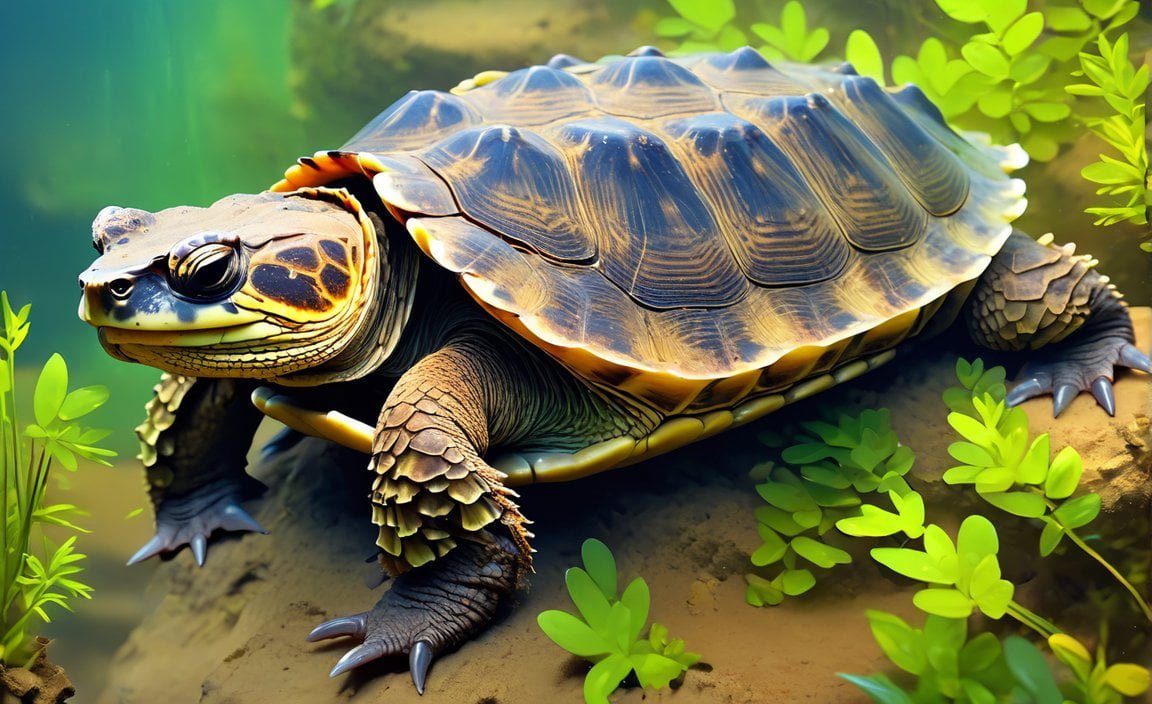Discover 10 Fascinating Facts: Alligator Snapping Turtles

Prepare to embark on a journey through the captivating world of alligator snapping turtles, as we unveil ten intriguing facts about these ancient creatures. With their formidable size, unique feeding habits, remarkable lifespan, and critical role in freshwater ecosystems, these remarkable reptiles have captured the attention of wildlife enthusiasts and scientists alike. Join us as we dive into the realm of these extraordinary turtles, uncovering the secrets and wonders that make them such mesmerizing creatures.
Key Takeaways:
- Alligator snapping turtles are endangered due to habitat loss and over-harvesting.
- They are the largest freshwater turtles, weighing up to 175 pounds and measuring up to 26 inches.
- Alligator snapping turtles have spiky ridges on their shells, resembling the armor of alligators.
- They have a carnivorous diet, primarily feeding on fish.
- Alligator snapping turtles have a longer lifespan than common snapping turtles.
- Male alligator snapping turtles are larger than females.
- The shell of an alligator snapping turtle can vary in color, often covered with algae for camouflage.
- Conservation efforts are necessary to protect these remarkable creatures and their habitats.
10 Interesting Facts About Alligator Snapping Turtles
Alligator snapping turtles, scientifically known as Macrochelys temminckii, are intriguing reptiles that can be found in the southeastern United States. Here are ten fascinating facts about these unique creatures:
1. Endangered Species
Did you know that alligator snapping turtles are protected by law and considered endangered in several states? This is due to habitat loss and over-harvesting. It is important that we take action to conserve these amazing creatures and their habitats [^1^].
2. Largest Freshwater Turtles
Alligator snapping turtles hold the record for being the largest freshwater turtles in the world! They can weigh between 155 to 175 pounds and reach up to 26 inches in length. These impressive dimensions make them true giants among their reptilian counterparts ^1^.
3. Distinctive Appearance
One of the most captivating features of alligator snapping turtles is their distinctive appearance. They have spiky ridges on their shells, which resemble the armor of alligators. This unique adaptation not only provides protection but also adds to their overall allure ^1^.
4. Carnivorous Diet
These turtles are known for their carnivorous diet. Their menu primarily consists of fish, which reflects their preference for living in freshwater habitats, often found near rivers and swamps. With their powerful jaws, these reptiles are designed to be expert hunters [^1^].
5. Longevity
Alligator snapping turtles have an impressive lifespan, living up to 15 years longer than common snapping turtles. This longevity allows them to witness and contribute to the intricate ecosystem dynamics of freshwater environments for many years [^1^].
6. Sexual Dimorphism
Male alligator snapping turtles are larger than females. This difference in size is a result of sexual dimorphism, a common trait among many reptiles. The larger size of males may be a competitive advantage during mating season [^1^].
7. Variety of Shell Colors
The shell of an alligator snapping turtle can display a range of colors, including grey, black, brown, or even a greenish hue. Additionally, these shells are often covered with algae, further providing camouflage in the murky waters that these turtles inhabit ^2^.
8. Impressive Bite Force
Alligator snapping turtles are renowned for their incredibly powerful bite force. It is estimated to be one of the strongest among all known turtle species. This adaptation enables them to capture and devour their prey with astonishing efficiency ^2^.
9. Patient Hunters
When it comes to hunting, alligator snapping turtles possess incredible patience. They lure their prey, typically fish, by using a specialized tongue that resembles a worm. The turtles remain motionless, and when unsuspecting prey ventures into their trap, they swiftly strike with lightning-fast speed ^3^.
10. Ecological Importance
Aside from their captivating characteristics, alligator snapping turtles play a crucial role in maintaining freshwater ecosystems. As apex predators, they help regulate the population of various aquatic animals. By preserving their habitats and ensuring their survival, we can help maintain the delicate balance of these environments [^1^].
These ten facts shed light on the impressive size, unique feeding habits, remarkable lifespan, and crucial role that alligator snapping turtles play in maintaining freshwater ecosystems. By raising awareness and implementing conservation measures, we can protect and conserve these remarkable creatures for future generations to appreciate.
References:
[^1^]: Facts Vault. (n.d.). Facts about Snapping Turtles. Retrieved from thefactsvault.com
Check out these 10 fun facts about hawksbill sea turtles that will blow your mind! From their unique shell patterns to their impressive navigational abilities, these creatures are truly fascinating. 10 fun facts about hawksbill sea turtles
Did you know that there are several human foods that dogs can actually eat? Discover which ones are safe and nutritious for your furry friend. 10 human foods dogs can eat
Take a look at these 10 human foods that are good for dogs and can provide them with important nutrients. Find out how some common foods can benefit your canine companion. 10 human foods that are good for dogs
Ever wondered what it’s like to be a veterinarian? Dive into these 10 interesting facts about being a veterinarian and get a glimpse into the exciting and rewarding world of animal care. 10 interesting facts about being a veterinarian
Falcons are majestic creatures with impressive skills. Learn more about these fascinating birds of prey with these 10 interesting facts about falcons. You won’t believe what they’re capable of! 10 interesting facts about falcons
Discover the incredible world of hawksbill sea turtles with these 10 interesting facts. From their critical role in marine ecosystems to their stunning appearance, these turtles are truly remarkable. 10 interesting facts about hawksbill sea turtles
Learn all about hawksbill turtles with these 10 interesting facts. From their nesting habits to their diet, these turtles have some unique characteristics that will leave you amazed. 10 interesting facts about hawksbill turtles
Snapping turtles are known for their fierce nature. Get to know these intriguing reptiles better with these 10 interesting facts about snapping turtles. You won’t believe what they can do! 10 interesting facts about snapping turtles
The hawksbill sea turtle is a truly remarkable species. Delve into their world and discover 10 interesting facts about the hawksbill sea turtle, from their conservation status to their nesting habits. 10 interesting facts about the hawksbill sea turtle
Alligator Snapping Turtles: Amazing Longevity in the World of Turtles
Key Takeaways:
– Alligator snapping turtles have an average lifespan of around 50 to 100 years, making them one of the longest-living turtles on the planet.
– These fascinating creatures spend most of their lives in water and only venture onto land when females need to nest.
– Adult alligator snapping turtles face threats to their survival, including habitat loss, pollution, and overharvesting.
– Their impressive size and unique feeding habits make them a captivating species to study and admire.
– Conservation efforts are crucial to protect alligator snapping turtles and maintain healthy freshwater ecosystems.
The world of turtles is full of remarkable species, but few captivate the imagination quite like the alligator snapping turtle. With an average lifespan of around 50 to 100 years, these ancient creatures are among the longest-living members of the turtle family.
Alligator snapping turtles, scientifically known as Macrochelys temminckii, are primarily found in the rivers, canals, and lakes of the southeastern United States. They are known for their impressive longevity, and their ability to live for several decades is truly remarkable. With proper care and protection, these incredible creatures can thrive for half a century or more in the wild.
These turtles spend most of their lives submerged in water, only venturing onto land when females need to lay their eggs. In search of the perfect nesting spot, the females may travel up to 160 feet inland. Once the eggs are laid, they must incubate and hatch for the next generation to continue the cycle of life.
Despite their long lifespan and ability to adapt to various habitats, alligator snapping turtles face numerous threats to their survival. Human activities, such as habitat destruction, pollution, and overharvesting, have resulted in a significant decline in their population. It is crucial to implement conservation measures to protect these magnificent creatures and their freshwater ecosystems.
Now, let’s dive into ten captivating facts about these ancient turtles:
-
Impressive Size: Male alligator snapping turtles can grow to an average shell length of 26 inches and weigh about 175 pounds, while the smaller females reach around 50 pounds. Some individuals have even been known to exceed 220 pounds[^1][^2].
-
Distinctive Features: The alligator snapping turtle can be distinguished from the common snapping turtle by its spiked, dark-brown carapace (shell) and larger head. It possesses strong jaws and a hooked beak, which help it catch prey efficiently[^6].
-
Master Lure: Alligator snapping turtles have long, narrow tongues equipped with an appendage that resembles a worm. They use this lure to attract prey into their mouth, displaying an impressive hunting technique[^6].
-
Habitat and Conservation: These turtles rely on healthy freshwater ecosystems to thrive. Unfortunately, their populations are declining due to habitat loss, pollution, and overharvesting. Conservation efforts are essential to protect their habitats and ensure their continued existence[^7].
-
Captive Longevity: In captivity, alligator snapping turtles have been known to live up to 70 years, highlighting their potential longevity under suitable conditions[^5].
-
Aging Wonder: Meet Thunder, an alligator snapping turtle who resided at the Newport Aquarium. Estimated to be 150 years old, she held the title of the oldest known snapping turtle, showcasing their extraordinary lifespan[^5].
Alligator snapping turtles are truly captivating creatures. Their large size, unique feeding habits, and incredible longevity make them a wonder to behold. However, despite their resilience, they require our protection and conservation efforts to ensure future generations can continue to marvel at their existence.
Sources:
[^1]: National Geographic: Alligator Snapping Turtle
[^2]: Britannica: Alligator Snapping Turtle
Alligator Snapping Turtles: A Symbiotic Relationship with Fish
Alligator snapping turtles, often referred to as the “dinosaur of the turtle world,” possess a fascinating secret hidden within their unique biology. These ancient creatures have evolved a symbiotic relationship with certain fish species, providing a means of transportation for the fish while benefiting from the food scraps left behind. This symbiotic bond showcases the incredible complexity and interconnectedness of freshwater ecosystems. Here are ten captivating facts about the alligator snapping turtle’s symbiotic relationship with fish:
Fact 1: Bringing Back an Ancient Partnership
Alligator snapping turtles and specific fish species have maintained this symbiotic relationship for millions of years—a testament to the resilience of nature’s alliances. These extraordinary alliances are a glimpse into the intricate web of interactions that exist within freshwater ecosystems.
Fact 2: A Safe and Convenient Ride
Certain fish, such as the common [fish species], have found an ingenious method of transportation with the alligator snapping turtle. By hopping on the turtle’s massive shell, they can hitch a ride and navigate through the water more swiftly. This partnership benefits both parties involved.
Fact 3: Help for Hungry Turtles
In return for the lift, these fish species provide a valuable source of sustenance for the alligator snapping turtle. As the turtle moves through the water, bits of food scraps and algae flake off and become readily available to the accompanying fish, ensuring a reliable source of nutrients.
Fact 4: Conserving Energy
For the alligator snapping turtle, hunting large fish can be energy-intensive. By adopting this symbiotic relationship, the turtle conserves energy while still gaining access to vital sustenance. It’s a win-win situation!
Fact 5: A Delicate Balance
Maintaining this balance is crucial for both the alligator snapping turtle and the fish species involved. Any disruption in their delicate symbiotic relationship could have far-reaching consequences, highlighting the importance of preserving their natural habitats.
Fact 6: Nature’s Aquatic Taxi Service
The alligator snapping turtle acts as a reliable mode of transportation for these fish, allowing them to move more efficiently than they typically would on their own. This transportation benefits the fish, as it saves them energy and provides access to new food sources.
Fact 7: Diversity within the Symbiotic Circle
While the specific fish species involved may vary, the underlying concept remains the same: alligator snapping turtles provide a means of transportation, and in return, they benefit from the food scraps created during their joint journey. This symbiotic relationship is a testament to the intricacies of nature.
Fact 8: A Lesson in Interdependence
The symbiotic relationship between alligator snapping turtles and certain fish species provides valuable insights into the delicate balance of nature. It is a reminder that every organism plays a role within its ecosystem, with interconnectedness being a cornerstone of survival.
Fact 9: Preserving Fragile Alliances
Conservation efforts are crucial to protecting these ancient species and their intricate relationships. By preserving their habitats, we ensure the continued existence of such fascinating symbiotic partnerships, allowing future generations to appreciate and learn from their unique dynamics.
Fact 10: Unlocking the Secrets of Freshwater Ecosystems
Exploring the intricacies of the alligator snapping turtle’s symbiotic relationship with fish uncovers the hidden complexity of freshwater ecosystems. By studying these resilient creatures, we gain valuable insights into the interdependent relationships that define the natural world.
Key Takeaways:
- Alligator snapping turtles and certain fish have a long-standing symbiotic relationship.
- The turtles provide a means of transportation for fish, who hitch a ride on the turtle’s shell.
- In return, the turtle benefits from the fish scraps and nutrients that are left behind.
- The symbiotic bond showcases the complexity and interconnectedness of freshwater ecosystems.
- Conservation efforts are integral to preserving these delicate alliances.
Sources:
– Alligator Snapping Turtle – Wikipedia
– Alligator Snapping Turtle – an overview | ScienceDirect Topics
Conservation efforts are crucial for the survival of alligator snapping turtles, as their populations have been declining due to habitat loss and overharvesting.
Alligator snapping turtles, the largest freshwater turtles in North America and one of the largest in the world, are facing a decline in their populations. This decline is primarily attributed to habitat loss and overharvesting. To ensure the survival of these ancient creatures, conservation efforts are of utmost importance.
Key Takeaways:
– Alligator snapping turtles are the largest species of freshwater turtles in North America and are vital for maintaining healthy freshwater ecosystems.
– Conservation efforts focus on long-term population monitoring, habitat preservation, and research on tracking and documentation.
– The U.S. Fish and Wildlife Service has proposed listing the alligator snapping turtle as a threatened species, demonstrating the urgency of protecting their habitat and populations.
– Recreational harvest of alligator snapping turtles is prohibited in most states, with Louisiana and Mississippi being the exceptions.
– Commercial harvesting of alligator snapping turtles has been prohibited in several states to prevent further population depletion.
Conservation efforts play a crucial role in preserving the alligator snapping turtle population and their importance in maintaining the delicate balance of freshwater ecosystems. By implementing measures to protect their habitats and populations, we can ensure the survival of these remarkable and ancient creatures.
Citation:
– U.S. Fish and Wildlife Service

FAQ
Q1: What is the average lifespan of an alligator snapping turtle?
A1: Alligator snapping turtles have an impressive lifespan, living up to 50 to 100 years in the wild.
Q2: Are alligator snapping turtles considered endangered?
A2: Yes, alligator snapping turtles are considered endangered in several states due to habitat loss and over-harvesting.
Q3: How much do alligator snapping turtles weigh?
A3: Alligator snapping turtles are the largest freshwater turtles in the world and can weigh between 155 to 175 pounds.
Q4: What is the distinctive appearance of alligator snapping turtles?
A4: Alligator snapping turtles have spiky ridges on their shells, resembling the armor of alligators.
Q5: What do alligator snapping turtles eat?
A5: Alligator snapping turtles are carnivorous animals and primarily feed on fish, reflecting their location near freshwater rivers and lakes.
- Unveiling Bernhard Caesar Einstein’s Scientific Achievements: A Legacy in Engineering - July 15, 2025
- Uncover who is Jerry McSorley: CEO, Family Man, Business Success Story - July 15, 2025
- Discover Bernhard Caesar Einstein’s Scientific Contributions: Unveiling a Legacy Beyond Einstein - July 15, 2025















